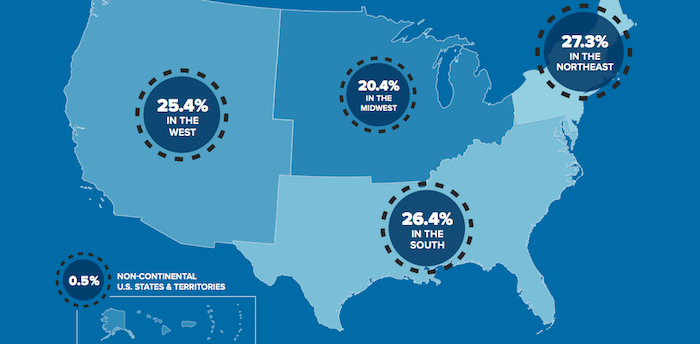There has been an 18% rise in the number of Nepalese students studying in the US over the last year, growing at a rate that far outstripped the overall 2% growth in international student numbers, which reached 1.18 million in May 2017.
News and business analysis for Professionals in International Education
Have some pie!
US: international students top 1.18 million
 The Northeast was the most popular US region for international students. Image: SEVIS by the numbers.
The Northeast was the most popular US region for international students. Image: SEVIS by the numbers. More than three-quarters (77%) of the 1,184,735 international students in the US on an F-1 (academic), M-1 (vocational) or J-1 (exchange visitor) visa came from Asia, SEVIS statistics show.
“We are encouraged to see growth in international students from countries such as Nepal”
Close to a third – 362,368 – came from China, while 206,698 came from India, up 7% on the previous year.
South Korea and Saudi Arabia followed some way behind with 71,204 and 55,806 students respectively. However, both markets saw a decrease in students coming to the US in 2017.
An 18% plummet in Saudi students follows a crash in oil prices and drastic cuts to the outbound King Abdullah Scholarship Program, which have dramatically curbed outbound mobility.
Meanwhile, the number of South Korean students dropped by 7%, following a worldwide trend that has taken shape in the last few years as fewer Korean students have opted to study abroad.
There was better news in Vietnam, the fifth largest source of students, where numbers climbed 6% to reach 30,279.
Taiwan, Canada, Japan, Brazil and Mexico completed the top 10 sending countries.
But the most notable shift came from the 11th largest source market, Nepal, which accounted for the most rapidly growing cohort of international students.
Nearly 15,000 Nepalese students were studying in the US in May 2017 – up 18% compared to the year before.
The sharp rise is in no small part driven by ongoing political turmoil in the country pushing students to look overseas, coupled with the after-effects of a devastating earthquake in April 2015 that killed nearly 9,000 people, according to Rajika Bhandari, IIE‘s deputy vice president, research and evaluation.
“The fact of the matter is that the earthquake about two years ago completely decimated the higher education infrastructure in Nepal,” Bhandari told The PIE News.
“And the US has a fairly large Nepalese diaspora, so students who have been displaced and were looking to go outside to study might be attracted to the US,” she added.
More than 3,000 students from Nepal were studying in Texas in May 2017, and Texas State University is one of a number of institutions that has seen an spike in interest from the country. Applications from Nepalese students to study at Texas State grew 92% between fall 2015 and fall 2016.
84% of Indian students in the US were studying STEM subjects
“We are encouraged to see growth in international students from countries such as Nepal, as we always welcome the diverse perspectives these students bring to our campus community,” commented Ryan Buck, assistant vice president for international affairs.
“These trends are positive for students, universities, and employers in Texas and around the world.”
California, New York and Texas retained their traditional positions as the top three destinations for international students, with just over a third of the total (35%) heading to one of the three states.
California alone claimed nearly a sixth of the US’s international students: 200,809 in total.
One in ten students attended one of just 10 education institutions: New York University, University of Southern California, Northeastern University, Columbia University, Arizona State University, University of Illinois, Purdue University, Pennsylvania State University, City University of New York and Indiana University.
But in contrast, 76% of schools hosting international students have 50 or fewer enrolled.
More than half of the US’s international students – nearly 514,000 – were enrolled on STEM degrees.
Of these STEM students, more than a third (39%) were enrolled on engineering courses.
The dominance of STEM shows no signs of waning, with the number of degree-level STEM students up 8% on last year: four times the overall growth rate.
India accounted for the largest number of STEM students – an unsurprising statistic, given that 84% of Indian students in the US were studying STEM subjects.
Still looking? Find by category:



SEVIS by the Numbers shows worrying trends in US international enrollments. The report shows visa holders who are in the US. Looking at trends since 2014: language study visa holder real numbers have dropped every semester since Spring 2015. Total visa holders from Spring 2014-2015 increased 117,459. 2015-2016 increase was 51,620 (the amount of increase decreased by over 50%), and Spring 2016 to 2017, the increase is only 424. Growth has slowed considerably over the past 2 years. Language visas have decreased over 25% from 105,207 in Spring 2015 78,338. The trends should be of ocncern.
Yeah! US seems to be education hub for the worldwide students, increasing rate of visiting US of Nepalese students for pursuing degree is rocketing these days rapidly and definitely will continue even in coming days due to the global recognize Universities with quality education system.
The days of students going to USA for further education has been decreasing since recent times. There are increasing number of other such opportunities with such level of quality education such as Australia, New Zealand, Canada.